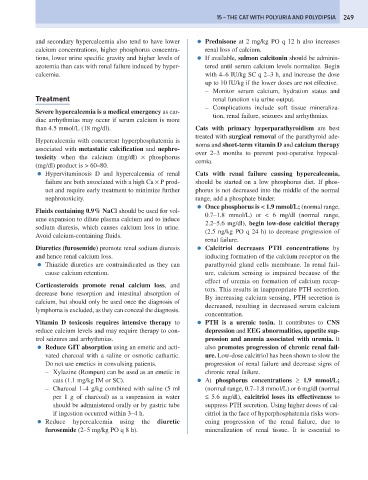Page 257 - Problem-Based Feline Medicine
P. 257
15 – THE CAT WITH POLYURIA AND POLYDIPSIA 249
and secondary hypercalcemia also tend to have lower ● Prednisone at 2 mg/kg PO q 12 h also increases
calcium concentrations, higher phosphorus concentra- renal loss of calcium.
tions, lower urine specific gravity and higher levels of ● If available, salmon calcitonin should be adminis-
azotemia than cats with renal failure induced by hyper- tered until serum calcium levels normalize. Begin
calcemia. with 4–6 IU/kg SC q 2–3 h, and increase the dose
up to 10 IU/kg if the lower doses are not effective.
– Monitor serum calcium, hydration status and
Treatment renal function via urine output.
– Complications include soft tissue mineraliza-
Severe hypercalcemia is a medical emergency as car-
tion, renal failure, seizures and arrhythmias.
diac arrhythmias may occur if serum calcium is more
than 4.5 mmol/L (18 mg/dl). Cats with primary hyperparathyroidism are best
treated with surgical removal of the parathyroid ade-
Hypercalcemia with concurrent hyperphosphatemia is
noma and short-term vitamin D and calcium therapy
associated with metastatic calcification and nephro-
over 2–3 months to prevent post-operative hypocal-
toxicity when the calcium (mg/dl) × phosphorus
cemia.
(mg/dl) product is > 60–80.
● Hypervitaminosis D and hypercalcemia of renal Cats with renal failure causing hypercalcemia,
failure are both associated with a high Ca × P prod- should be started on a low phosphorus diet. If phos-
uct and require early treatment to minimize further phorus is not decreased into the middle of the normal
nephrotoxicity. range, add a phosphate binder.
● Once phosphorus is < 1.9 mmol/L; (normal range,
Fluids containing 0.9% NaCl should be used for vol-
0.7–1.8 mmol/L) or < 6 mg/dl (normal range,
ume expansion to dilute plasma calcium and to induce
2.2–5.6 mg/dl), begin low-dose calcitiol therapy
sodium diuresis, which causes calcium loss in urine.
(2.5 ng/kg PO q 24 h) to decrease progression of
Avoid calcium-containing fluids.
renal failure.
Diuretics (furosemide) promote renal sodium diuresis ● Calcitriol decreases PTH concentrations by
and hence renal calcium loss. inducing formation of the calcium receptor on the
● Thiazide diuretics are contraindicated as they can parathyroid gland cells membrane. In renal fail-
cause calcium retention. ure, calcium sensing is impaired because of the
effect of uremia on formation of calcium recep-
Corticosteroids promote renal calcium loss, and
tors. This results in inappropriate PTH secretion.
decrease bone resorption and intestinal absorption of
By increasing calcium sensing, PTH secretion is
calcium, but should only be used once the diagnosis of
decreased, resulting in decreased serum calcium
lymphoma is excluded, as they can conceal the diagnosis.
concentration.
Vitamin D toxicosis requires intensive therapy to ● PTH is a uremic toxin. It contributes to CNS
reduce calcium levels and may require therapy to con- depression and EEG abnormalities, appetite sup-
trol seizures and arrhythmias. pression and anemia associated with uremia. It
● Reduce GIT absorption using an emetic and acti- also promotes progression of chronic renal fail-
vated charcoal with a saline or osmotic cathartic. ure. Low-dose calcitriol has been shown to slow the
Do not use emetics in convulsing patients. progression of renal failure and decrease signs of
– Xylazine (Rompun) can be used as an emetic in chronic renal failure.
cats (1.1 mg/kg IM or SC). ● At phosphorus concentrations ≥ 1.9 mmol/L;
– Charcoal 1–4 g/kg combined with saline (5 ml (normal range, 0.7–1.8 mmol/L) or 6 mg/dl (normal
per 1 g of charcoal) as a suspension in water ≤ 5.6 mg/dl), calcitriol loses its effectiveness to
should be administered orally or by gastric tube suppress PTH secretion. Using higher doses of cal-
if ingestion occurred within 3–4 h. citriol in the face of hyperphosphatemia risks wors-
● Reduce hypercalcemia using the diuretic ening progression of the renal failure, due to
furosemide (2–5 mg/kg PO q 8 h). mineralization of renal tissue. It is essential to

